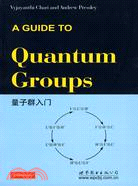人民幣定價:75 元
定價
:NT$ 450 元優惠價
:87 折 392 元
絕版無法訂購
商品簡介
目次
相關商品
商品簡介
quantum groups first arose in the physics literature, particularly in the work of L. D. Faddeev and the Leningrad school, from the inverse scattering method, which had been developed to construct and solve integrable quantum systems. They have excited great interest in the past few years because of their unexpected connections with such, at first sight, unrelated parts of mathematics as the construction of knot invariants and the representation theory of algebraic groups in characteristic p.
In their original form, quantum groups are associative algebras whose defin-ing relations are expressed in terms of a matrix of constants (depending on the integrable system under consideration) called a quantum R-matrix. It was realized independently by V. G. Drinfeld and M. Jimbo around 1985 that these algebras are Hopf algebras, which, in many cases, are deformations of universal enveloping algebras of Lie algebras. A little later, Yu. I. Manin and S. L. Woronowicz independently constructed non-commutative deforma-tions of the algebra of functions on the groups SL2(C) and SU2, respectively,and showed that many of the classical results about algebraic and topological groups admit analogues in the non-commutative case.
In their original form, quantum groups are associative algebras whose defin-ing relations are expressed in terms of a matrix of constants (depending on the integrable system under consideration) called a quantum R-matrix. It was realized independently by V. G. Drinfeld and M. Jimbo around 1985 that these algebras are Hopf algebras, which, in many cases, are deformations of universal enveloping algebras of Lie algebras. A little later, Yu. I. Manin and S. L. Woronowicz independently constructed non-commutative deforma-tions of the algebra of functions on the groups SL2(C) and SU2, respectively,and showed that many of the classical results about algebraic and topological groups admit analogues in the non-commutative case.
目次
Introduction
1 Poisson-Lie groups and Lie bialgebras
1.1 Poisson manifolds
1.2 Poisson-Lie groups
1.3 Lie bialgebras
1.4 Duals and doubles
1.5 Dressing actions and symplectic leaves
1.6 Deformation of Poisson structures and quantization
Bibliographical notes
2 Coboundary Poisson-Lie groups and the classical Yang-Baxter equation
2.1 Coboundary Lie bialgebras
2.2 Coboundary Poisson-Lie groups
2.3 Classical integrable systems
Bibliographical notes
3 Solutions of the classical Yang-Baxter equation
3.1 Constant solutions of the CYBE
3.2 Solutions of the CYBE with spectral parameters
Bibliographical notes
4 Quasitriangular Hopf algebras
4.1 Hopf algebras
4.2 Quasitriangular Hopf algebras
Bibliographical notes
5 Representations and quasitensor categories
5.1 Monoidal categories
5.2 Quasitensor categories
5.3 Invariants of ribbon tangles
Bibliographical notes
6 Quantization of Lie bialgebras
6.1 Deformations of Hopf algebras
6.2 Quantization
6.3 Quantized universal enveloping algebras
6.4 The basic example
6.5 Quantum Kac-Moody algebras
Bibliographical notes
7 Quantized function algebras
7.1 The basic example
7.2 R-matrix quantization
7.3 Examples of quantized function algebras
7.4 Differential calculus on quantum groups
7.5 Integrable lattice models
Bibliographical notes
8 Structure of QUE algebras:the universal R-matrix
8.1 The braid group action
8.2 The quantum Weyl group
8.3 The quasitriangular structure
Bibliographical notes
9 Specializations of QUE algebras
9.1 Rational forms
9.2 The non-restricted specialization
9.3 The restricted specialization
9.4 Automorphisms and real forms
Bibliographical notes
10 Representations of QUE algebras: the generic casa
10.1 Classification of finite-dimensional representations
10.2 Quantum invariant theory
Bibliographical notes
11 Representations of QUE algebras:the root of unity case
11.1 The non-restricted case
11.2 The restricted case
11.3 Tilting modules and the fusion tensor product
Bibliographical notes
12 Infinite-dimensional quantum groups
12.1 Yangians and their representations
12.2 Quantum afiine algebras
12.3 Frobenius-Schur duality for Yangians and quantum affine algebras
12.4 Yangians and infinite-dimensional classical groups
12.5 Rational and trigonometric solutions of the QYBE
Bibliographical notes
13 Quantum harmonic analysis
13.1 Compact quantum groups and their representations
13.2 Quantum homogeneous spaces
13.3 Compact matrix quantum groups
13.4 A non-compact quantum group
13.5 q-special functions
Bibliographical notes
14 Canonical bases
14.1 Crystal bases
14.2 Lusztigs canonical bases
Bibliographical notes
15 Quantum group invariants of knots and 3-manifolds
15.1 Knots and 3-manifolds: a quick review
15.2 Link invariants from quantum groups
15.3 Modular Hopf algebras and 3-manifold invariants
Bibliographical notes
16 Quasi-Hopf algebras and the Knizhnik-Zamolodchikov equation
16.1 Quasi-Hopf algebras
16.2 The Kohno-Drinfeld monodromy theorem
16.3 Affine Lie algebras and quantum groups
16.4 Quasi-Hopf algebras and Grothendiecks esquisse
Bibliographical notes
Appendix Kac-Moody algebras
A 1 Generalized Cartan matrices
A 2 Kac-Moody algebras
A 3 The invariant bilinear form
A 4 Roots
A 5 The Weyl group
A 6 Root vectors
A 7 Aide Lie algebras
A 8 Highest weight modules
References
Index of notation
General index
1 Poisson-Lie groups and Lie bialgebras
1.1 Poisson manifolds
1.2 Poisson-Lie groups
1.3 Lie bialgebras
1.4 Duals and doubles
1.5 Dressing actions and symplectic leaves
1.6 Deformation of Poisson structures and quantization
Bibliographical notes
2 Coboundary Poisson-Lie groups and the classical Yang-Baxter equation
2.1 Coboundary Lie bialgebras
2.2 Coboundary Poisson-Lie groups
2.3 Classical integrable systems
Bibliographical notes
3 Solutions of the classical Yang-Baxter equation
3.1 Constant solutions of the CYBE
3.2 Solutions of the CYBE with spectral parameters
Bibliographical notes
4 Quasitriangular Hopf algebras
4.1 Hopf algebras
4.2 Quasitriangular Hopf algebras
Bibliographical notes
5 Representations and quasitensor categories
5.1 Monoidal categories
5.2 Quasitensor categories
5.3 Invariants of ribbon tangles
Bibliographical notes
6 Quantization of Lie bialgebras
6.1 Deformations of Hopf algebras
6.2 Quantization
6.3 Quantized universal enveloping algebras
6.4 The basic example
6.5 Quantum Kac-Moody algebras
Bibliographical notes
7 Quantized function algebras
7.1 The basic example
7.2 R-matrix quantization
7.3 Examples of quantized function algebras
7.4 Differential calculus on quantum groups
7.5 Integrable lattice models
Bibliographical notes
8 Structure of QUE algebras:the universal R-matrix
8.1 The braid group action
8.2 The quantum Weyl group
8.3 The quasitriangular structure
Bibliographical notes
9 Specializations of QUE algebras
9.1 Rational forms
9.2 The non-restricted specialization
9.3 The restricted specialization
9.4 Automorphisms and real forms
Bibliographical notes
10 Representations of QUE algebras: the generic casa
10.1 Classification of finite-dimensional representations
10.2 Quantum invariant theory
Bibliographical notes
11 Representations of QUE algebras:the root of unity case
11.1 The non-restricted case
11.2 The restricted case
11.3 Tilting modules and the fusion tensor product
Bibliographical notes
12 Infinite-dimensional quantum groups
12.1 Yangians and their representations
12.2 Quantum afiine algebras
12.3 Frobenius-Schur duality for Yangians and quantum affine algebras
12.4 Yangians and infinite-dimensional classical groups
12.5 Rational and trigonometric solutions of the QYBE
Bibliographical notes
13 Quantum harmonic analysis
13.1 Compact quantum groups and their representations
13.2 Quantum homogeneous spaces
13.3 Compact matrix quantum groups
13.4 A non-compact quantum group
13.5 q-special functions
Bibliographical notes
14 Canonical bases
14.1 Crystal bases
14.2 Lusztigs canonical bases
Bibliographical notes
15 Quantum group invariants of knots and 3-manifolds
15.1 Knots and 3-manifolds: a quick review
15.2 Link invariants from quantum groups
15.3 Modular Hopf algebras and 3-manifold invariants
Bibliographical notes
16 Quasi-Hopf algebras and the Knizhnik-Zamolodchikov equation
16.1 Quasi-Hopf algebras
16.2 The Kohno-Drinfeld monodromy theorem
16.3 Affine Lie algebras and quantum groups
16.4 Quasi-Hopf algebras and Grothendiecks esquisse
Bibliographical notes
Appendix Kac-Moody algebras
A 1 Generalized Cartan matrices
A 2 Kac-Moody algebras
A 3 The invariant bilinear form
A 4 Roots
A 5 The Weyl group
A 6 Root vectors
A 7 Aide Lie algebras
A 8 Highest weight modules
References
Index of notation
General index
主題書展
更多
主題書展
更多書展今日66折
您曾經瀏覽過的商品
購物須知
大陸出版品因裝訂品質及貨運條件與台灣出版品落差甚大,除封面破損、內頁脫落等較嚴重的狀態,其餘商品將正常出貨。
特別提醒:部分書籍附贈之內容(如音頻mp3或影片dvd等)已無實體光碟提供,需以QR CODE 連結至當地網站註冊“並通過驗證程序”,方可下載使用。
無現貨庫存之簡體書,將向海外調貨:
海外有庫存之書籍,等候約45個工作天;
海外無庫存之書籍,平均作業時間約60個工作天,然不保證確定可調到貨,尚請見諒。
為了保護您的權益,「三民網路書店」提供會員七日商品鑑賞期(收到商品為起始日)。
若要辦理退貨,請在商品鑑賞期內寄回,且商品必須是全新狀態與完整包裝(商品、附件、發票、隨貨贈品等)否則恕不接受退貨。
























